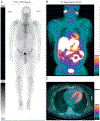How to Image Cardiac Amyloidosis: A Practical Approach
- PMID: 31607664
- PMCID: PMC7148180
- DOI: 10.1016/j.jcmg.2019.07.015
How to Image Cardiac Amyloidosis: A Practical Approach
Abstract
Cardiac amyloidosis (CA) is one of the most rapidly progressive forms of heart disease, with a median survival from diagnosis, if untreated, ranging from <6 months for light chain amyloidosis to 3 to 5 years for transthyretin amyloidosis. Early diagnosis and accurate typing of CA are necessary for optimal management of these patients. Emerging novel disease modifying therapies increase the urgency to diagnose CA at an early stage and identify patients who may benefit from these life-saving therapies. The goal of this review is to provide a practical approach to echocardiography, cardiac magnetic resonance, and radionuclide imaging in patients with known or suspected CA.
Keywords: CMR; PET; Tc-99m−PYP; amyloid tracers; cardiac amyloidosis; cardiac magnetic resonance; echocardiography; imaging; multimodality; pyrophosphate; radionuclide imaging.
Copyright © 2020 American College of Cardiology Foundation. Published by Elsevier Inc. All rights reserved.
Figures








Comment in
-
Imaging Cardiac Amyloidosis: An Update for the Cardiothoracic Anesthesiologist.J Cardiothorac Vasc Anesth. 2021 Jul;35(7):1911-1916. doi: 10.1053/j.jvca.2021.02.040. Epub 2021 Feb 19. J Cardiothorac Vasc Anesth. 2021. PMID: 33736913 No abstract available.
References
-
- Glenner GG, Terry W, Harada M, Isersky C, Page D. Amyloid fibril proteins: proof of homology with immunoglobulin Light chains by sequence analyses. Science 1971;172:1150–1. - PubMed
-
- Gonzalez-Lopez E, Gallego-Delgado M, Guzzo-Merello G, et al. Wild-type transthyretin amyloidosis as a cause of heart failure with preserved ejection fraction. Eur Heart J 2015;36:2585–94. - PubMed
Publication types
MeSH terms
Supplementary concepts
Grants and funding
LinkOut - more resources
Full Text Sources
Other Literature Sources
Medical
Research Materials

